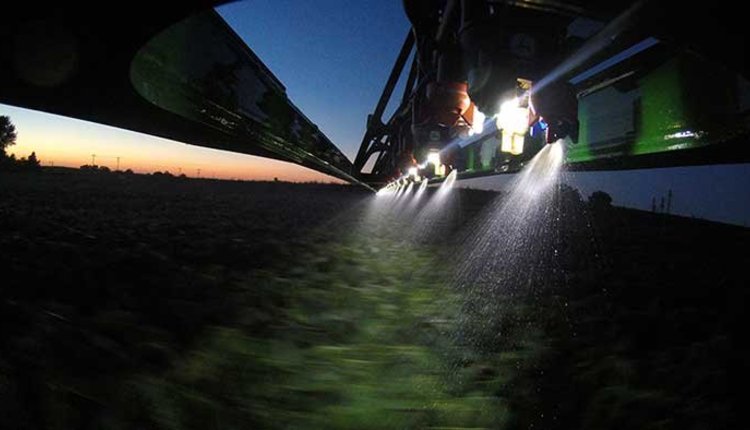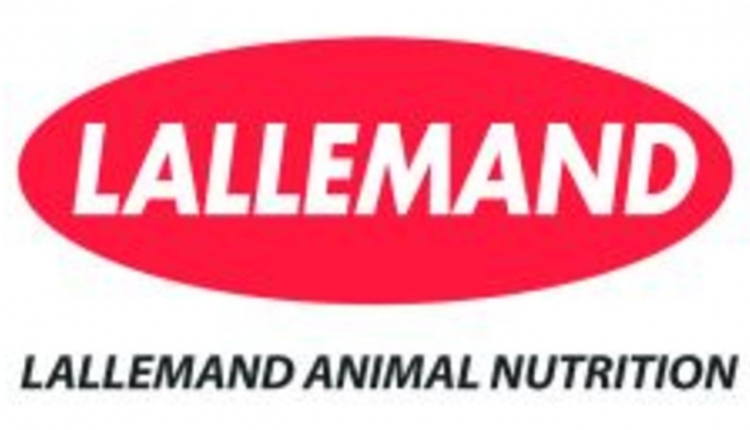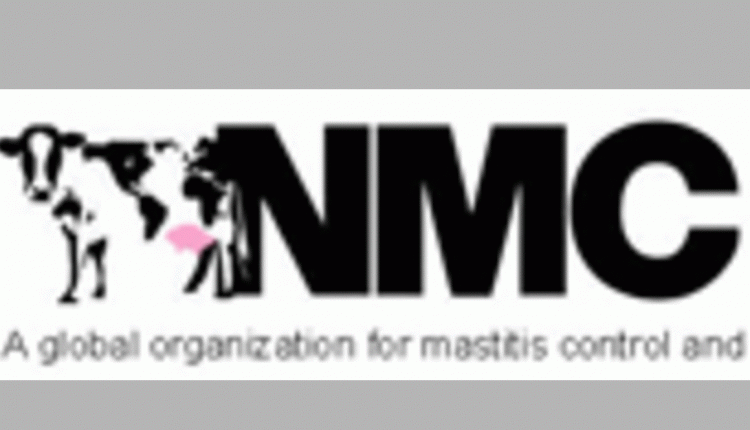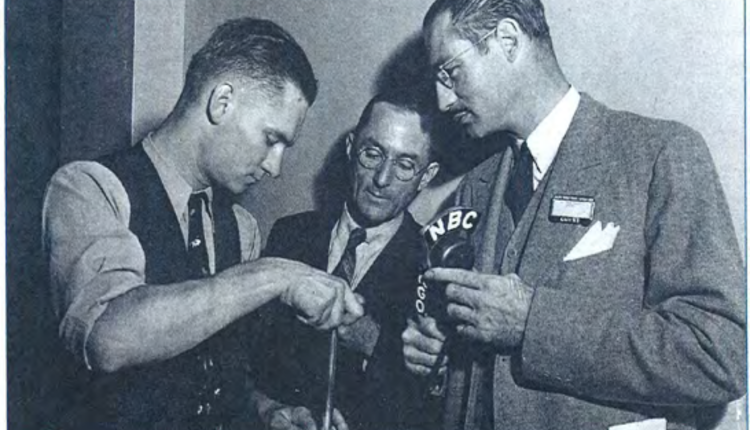Like Kryptonite hidden from Superman until it was too late, a similar foe hides from dairy producers only to strike when little can be done to stop it.
This dairy assailant is Cryptosporidium parvum (C. parvum), a parasitic protozoan and primary cause of scours. With four other common causes of scours, many producers often skip testing sick calves and try to manage the symptoms.
Without a vaccine, C. parvum has run unchecked in dairy herds across the country. Hutches, water and feed supplies can be carriers of the oocysts, allowing the disease to spread within herds. Since most chemical and thermal sanitation methods don't kill C. parvum, it's not really a matter of if C. parvum will cause scours in your herd, but when. Multiple research studies have shown that up to 92% of calves younger than four months test positive for C. parvum and are shedding the C. parvum organism, with or without clinical signs of disease. It is found in all calf-housing systems and in all regions.
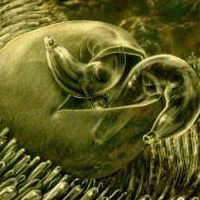
C. parvum is transmitted through ingestion of oocysts, protozoan eggs.
Researchers have tried to find cures for C. parvum, but most treatments only focused on one stage of the disease.
"In the past, researchers focused solely on the oocyst, which is the end infectious stage of protozoans like C. parvum," says Mark Welter, President of Oragen Technologies, Inc. in Des Moines, Iowa. "Oocysts are shed by the animal in their feces. So they tried using oocysts as an antigen to make vaccines, but that didn't work. We found that C. parvum has many life cycle stages. So focusing on one stage is insufficient."
About 50% of calf deaths before weaning are due to scours. 23% of those are attributed to C. parvum.
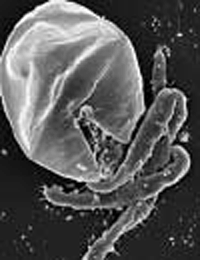 It's not just the calves that are in danger from C. parvum, it is also a threat to humans. Since it is resistant to bleaches and soaps, C. parvum can be found in watersheds, swimming pools and day care centers. It can be devastating to immune compromised people and young children. In 1993, 403,000 people in Milwaukee were infected with C. parvum, due to infected water supplies. With dairies and cities getting closer than ever before, human health threats are a major concern for US dairy producers.
It's not just the calves that are in danger from C. parvum, it is also a threat to humans. Since it is resistant to bleaches and soaps, C. parvum can be found in watersheds, swimming pools and day care centers. It can be devastating to immune compromised people and young children. In 1993, 403,000 people in Milwaukee were infected with C. parvum, due to infected water supplies. With dairies and cities getting closer than ever before, human health threats are a major concern for US dairy producers.
Scours caused by C. parvum affects calves 5 to 35 days old.
The Center for Disease Control and Prevention says, ‘Cryptosporidium has become recognized as one of the most common causes of waterborne disease (recreational water and drinking water) in humans in the United States. The parasite is found in every region of the United States and throughout the world.'
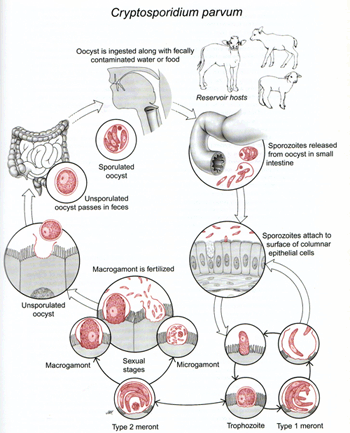
This is a good visual of the life cycle
"The best defense against this disease is to prevent the oocyst," says Welter, who has been working on a vaccine for C. parvum for close to 18 years. "That's what gets into watersheds and infects humans. Since bleach and other filtration systems do not work against C. parvum, it has to be controlled at the source."
It is estimated that 1 million humans are infected by C. parvum each year.
A new scientific breakthrough is poised to give producers control of this persistent parasite. Similar to the flu vaccine, Welter has developed and patented a process to generate killed C. parvum proteins in every stage of its life cycle. The killed C. parvum proteins are delivered in a liquid form that can be mixed with milk replacer and fed to calves. It allows the calf an opportunity to produce an immune response without being attacked by the parasite. Then when the parasite is present, the calf will be primed to fight it.
Soon producers will be able to prevent C. parvum induced scours, rather than just react to the symptoms. Preventing the spread of this highly infectious disease will not only help calves stay healthy and strong, but the humans around them too.
09.13.2012
This dairy assailant is Cryptosporidium parvum (C. parvum), a parasitic protozoan and primary cause of scours. With four other common causes of scours, many producers often skip testing sick calves and try to manage the symptoms.
Without a vaccine, C. parvum has run unchecked in dairy herds across the country. Hutches, water and feed supplies can be carriers of the oocysts, allowing the disease to spread within herds. Since most chemical and thermal sanitation methods don't kill C. parvum, it's not really a matter of if C. parvum will cause scours in your herd, but when. Multiple research studies have shown that up to 92% of calves younger than four months test positive for C. parvum and are shedding the C. parvum organism, with or without clinical signs of disease. It is found in all calf-housing systems and in all regions.

C. parvum is transmitted through ingestion of oocysts, protozoan eggs.
Researchers have tried to find cures for C. parvum, but most treatments only focused on one stage of the disease.
"In the past, researchers focused solely on the oocyst, which is the end infectious stage of protozoans like C. parvum," says Mark Welter, President of Oragen Technologies, Inc. in Des Moines, Iowa. "Oocysts are shed by the animal in their feces. So they tried using oocysts as an antigen to make vaccines, but that didn't work. We found that C. parvum has many life cycle stages. So focusing on one stage is insufficient."
About 50% of calf deaths before weaning are due to scours. 23% of those are attributed to C. parvum.
 It's not just the calves that are in danger from C. parvum, it is also a threat to humans. Since it is resistant to bleaches and soaps, C. parvum can be found in watersheds, swimming pools and day care centers. It can be devastating to immune compromised people and young children. In 1993, 403,000 people in Milwaukee were infected with C. parvum, due to infected water supplies. With dairies and cities getting closer than ever before, human health threats are a major concern for US dairy producers.
It's not just the calves that are in danger from C. parvum, it is also a threat to humans. Since it is resistant to bleaches and soaps, C. parvum can be found in watersheds, swimming pools and day care centers. It can be devastating to immune compromised people and young children. In 1993, 403,000 people in Milwaukee were infected with C. parvum, due to infected water supplies. With dairies and cities getting closer than ever before, human health threats are a major concern for US dairy producers.Scours caused by C. parvum affects calves 5 to 35 days old.
The Center for Disease Control and Prevention says, ‘Cryptosporidium has become recognized as one of the most common causes of waterborne disease (recreational water and drinking water) in humans in the United States. The parasite is found in every region of the United States and throughout the world.'

"The best defense against this disease is to prevent the oocyst," says Welter, who has been working on a vaccine for C. parvum for close to 18 years. "That's what gets into watersheds and infects humans. Since bleach and other filtration systems do not work against C. parvum, it has to be controlled at the source."
It is estimated that 1 million humans are infected by C. parvum each year.
A new scientific breakthrough is poised to give producers control of this persistent parasite. Similar to the flu vaccine, Welter has developed and patented a process to generate killed C. parvum proteins in every stage of its life cycle. The killed C. parvum proteins are delivered in a liquid form that can be mixed with milk replacer and fed to calves. It allows the calf an opportunity to produce an immune response without being attacked by the parasite. Then when the parasite is present, the calf will be primed to fight it.
Soon producers will be able to prevent C. parvum induced scours, rather than just react to the symptoms. Preventing the spread of this highly infectious disease will not only help calves stay healthy and strong, but the humans around them too.
09.13.2012
